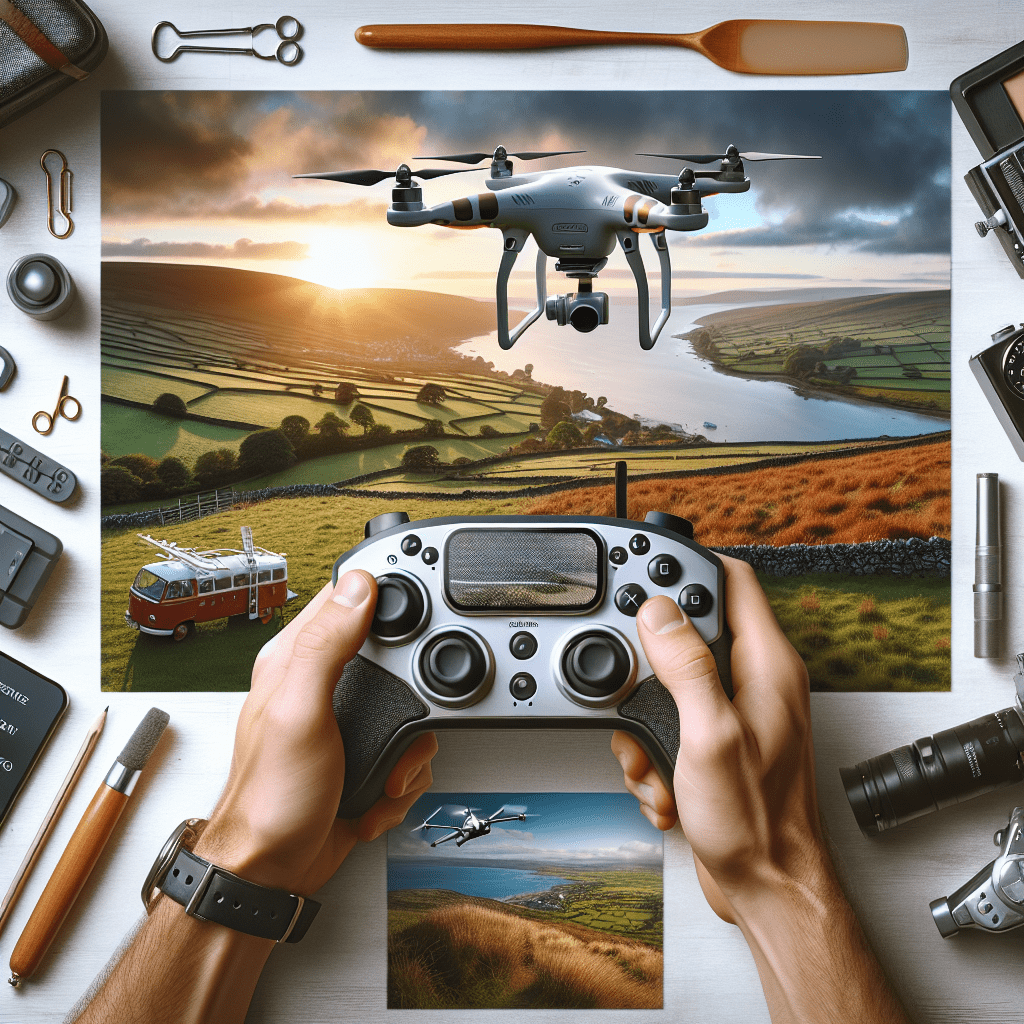UK Drone Photography Basics: Beginner’s Laws & Gear Guide
In This Article
- Always understand and follow UK CAA regulations before flying
- Start with a user-friendly drone with safety features
- Study basic camera settings to gain manual control
- Use planning tools to avoid restricted airspace zones
- Practise safe flying in legal, open areas
- Enhance your photos with editing software and proper storage
- Watch the weather and avoid flying in rain or strong winds
- Be vigilant about GDPR and general privacy laws
Why Drone Photography is Booming in the UK
Exploring the rise of hobby and commercial drone use
UK Drone Photography Basics have become a major focus for hobbyists and professionals alike. Over the past five years, drone usage in the United Kingdom has surged dramatically, driven by more affordable equipment, enhanced camera technologies, and the expanding social media landscape. Aerial photos and videos now grace everything from real estate listings to wedding albums and cinematic productions.
One contributing factor to this spike is the dynamic and varied UK terrain. Locations such as the Lake District, Snowdonia, and the Jurassic Coast provide stunning backdrops ideal for aerial capture. As technology becomes more accessible, individuals with a variety of skill levels are exploring this medium not just recreationally, but also professionally in sectors ranging from agriculture to construction and surveying.

Essential Drone Regulations You Must Know
UK CAA rules and GDPR privacy requirements
When delving into UK Drone Photography Basics, understanding the legal framework is paramount. The UK’s Civil Aviation Authority (CAA) manages drone regulation. Recreational users must follow the Drone and Model Aircraft Code. This includes registering their drone, passing an online theory test, and displaying their operator ID on the device.
A major point is the distinction between drones below and above 250 grams. Lighter drones are subject to fewer restrictions, though users must still respect safety distances. Heavier drones require more stringent controls, particularly in urban or crowded areas. Additionally, commercial drone operations necessitate an Operational Authorisation from the CAA under the UK Specific category.
From a privacy standpoint, photographers must consider GDPR implications. Capturing identifiable individuals in public or private spaces without consent could potentially breach privacy laws. Therefore, ethical operation is just as important as technical proficiency.
“Fly smart, fly legal. Understanding drone rules is just as essential as knowing how to pilot one.”
Choosing Your First Drone: What To Look For
Embarking on your journey into UK Drone Photography Basics requires selecting the right device to meet your goals. For beginners, models like the DJI Mini 3 or the Autel EVO Nano are lightweight, user-friendly, and sufficiently powerful for stunning images. They fall under the 250g threshold, minimising regulatory compression.
Look for features that enhance ease of use and photo quality. These include:
- Stabilised gimbals for smooth footage
- High-resolution cameras (at least 12MP)
- Extended battery life (20-30 minutes minimum)
- GPS functionality for precision flying
- Beginners’ modes or obstacle avoidance sensors
While budget is a consideration, opting for a reputable brand with reliable support and firmware updates is advisable. Remember, your drone is an investment in both your creative and compliance journey.
Tips for Safe and Legal Drone Operation
For newcomers, operating within safety guidelines is central to mastering UK Drone Photography Basics. Start by scouting your location in advance using digital airspace maps such as Altitude Angel’s Drone Assist app. These tools highlight restricted areas, such as airfields or conservation zones.
Always maintain visual line of sight (VLOS) with your device. That means no flying behind buildings or beyond natural obstacles like hills. Keep the drone below 400 feet (120 metres) to avoid conflicting with manned aircraft operations.
Weather also plays a critical role. Gusty winds, fog, or heavy rain can compromise both image quality and drone stability. Safety tip: Always conduct a pre-flight checklist that includes checking battery levels, signal strength, propeller integrity, and calibration settings.
Understanding UK Airspace and Flight Restrictions
Airspace in the UK is governed through complex classifications. Class G is uncontrolled and usually where hobbyist drone usage is permitted. Flying in zones around airports, military installations, or large events is forbidden without prior authorisation.
TFRs (Temporary Flight Restrictions) and FRZs (Flight Restriction Zones) are particularly important to note. These areas often change dynamically, especially during emergencies or major gatherings. Staying up to date through CAA bulletins and apps is non-negotiable for legal flight.
Additionally, when working near built-up areas, the minimum horizontal distance from uninvolved people must be observed — typically 50 metres. Ensure you consult the CAA’s guidelines for different fly categories: Open, Specific, and Certified.
The Basics of Drone Cameras & Settings
Learning your drone camera settings is a cornerstone of mastering UK Drone Photography Basics. Most consumer drones provide automated shooting modes, but manual settings yield much better control and artistry.
ISO, aperture (if adaptable), and shutter speed collectively define your exposure. Start with lower ISO settings to reduce image noise, and adjust shutter speed based on lighting conditions. For video, using ND (neutral density) filters can help maintain cinematic consistency without overexposure.
White balance should be manually set according to your lighting environment to ensure colour accuracy. Many drones allow you to shoot in RAW photo format, enabling extensive post-production flexibility without compromising on quality.
Aerial Photography Techniques for Beginners
Captivating aerial shots require more than elevation. Composition is key. Following the rule of thirds, leading lines, and utilising symmetry can transform an ordinary image into a compelling one. Try varying your altitude to discover unique perspectives: low, sweeping shots can be just as evocative as high-level panoramas.
Movement matters too. Instead of static photos, consider incorporating slow, deliberate motion via waypoints or point-of-interest tracking. However, ensure these functions are tested in open spaces before attempting intricate sequences.
Golden hour — the time shortly after sunrise or before sunset — provides warm, diffused lighting ideal for landscapes and architectural subjects. Plan your shoots accordingly, and be patient. Great drone photography often hinges on perfect timing.
Storing & Editing Your Drone Photos
Managing and post-processing your aerial visuals is an intrinsic part of the UK Drone Photography Basics toolkit. Invest in high-speed microSD cards to prevent data loss. Cloud storage options like Dropbox or Adobe Creative Cloud offer scalable backups and ease of access.
Editing software such as Adobe Lightroom or Capture One allows beginners to refine images – from contrast and sharpness adjustments to lens correction. For video, DaVinci Resolve offers a powerful, free suite suited to drone operators looking to film professionally.
A good workflow will include importing with metadata tags (such as date, location, and model used), basic correction, artistic grading, and final export in the appropriate format depending on the end use (e.g., web, print, or clients).
Best Places in the UK to Practice Drone Photography
Choosing photogenic and legally flyable locations is vital. The UK is blessed with numerous drone-friendly destinations. In England, the Yorkshire Dales and the South Downs provide expansive, picturesque fields perfect for practicing flight control and framing. In Scotland, Glencoe and the Isle of Skye are rich with dramatic landscapes, ideal for honing contrast and knowing when to utilise foreground elements.
Wales boasts Brecon Beacons and Pembrokeshire Coast National Park, while Northern Ireland’s Giant’s Causeway offers basaltic drama at every angle. Regardless of where you travel, always verify the landowner’s permissions and consult Learn more about Drone Photography & Operation for real-time updates on drone-permitted regions.
Beginner Mistakes to Avoid with Drone Photography
Becoming proficient in UK Drone Photography Basics involves recognising and rectifying early errors. Common pitfalls include:
- Ignoring weather reports, leading to unstable flights
- Flying indoors without GPS lock
- Relying solely on auto mode without experimenting with settings
- Neglecting to calibrate the compass and IMU sensors
- Flying without checking geofencing restrictions
Additionally, many overlook firmware updates or forget to bring spare batteries. These oversights can cost both time and valuable image opportunities. A responsible flyer learns from each sortie and aims to improve craft and compliance continuously.
Final Thoughts: Building Confidence with Drone Photography
[CONCLUSION_CONTENT]
UK Drone Photography Basics are an amalgamation of legal knowledge, technological fluency, and artistic expression. For novices, starting with the correct foundation ensures a safer and more rewarding experience. By committing to the rules, embracing continued learning, and seeking inspiration in the UK’s diverse geography, every beginner can transform into a skilled drone photographer. Explore more tips and drone experiment guides at Read a related article and connect with local communities to share your visual journey. For technical overlays and export advice, consider guidance from manufacturers’ pages like Legal guide to drone photography and privacy in the UK.
Great guide on beginners-guide-to-drone-photography-in-the-uk-interactive – Community Feedback
Is drone photography legal in the UK?
Yes, drone photography is legal in the UK. However, you must carefully follow GDPR and privacy laws. Capturing identifiable individuals requires a legal basis, like consent or legitimate interest.
Is it hard to learn drone photography?
Learning to fly a drone is relatively easy, but perfecting aerial photos takes practice. Review your footage and practice often before photographing important locations.
How much money do drone photographers make?
Earnings for drone photographers vary based on skill, project type, and location. New professionals typically start lower, while experienced photographers may command higher rates for commercial work.
Is it illegal to take pics with a drone?
It is illegal to take photos while trespassing or hovering over private land without permission. Drone photography is generally legal from public spaces if you follow laws and respect privacy.

